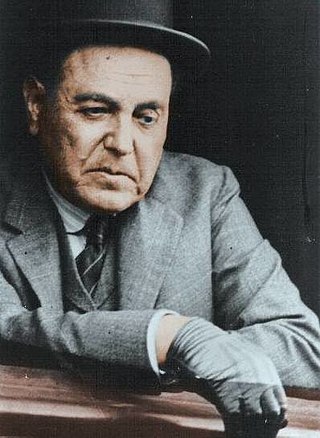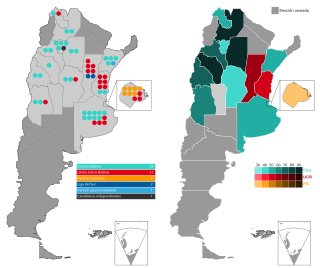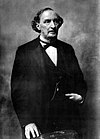
Juan Hipólito del Sagrado Corazón de Jesús Yrigoyen was an Argentine politician of the Radical Civic Union and two-time President of Argentina, who served his first term from 1916 to 1922 and his second term from 1928 to 1930. He was the first president elected democratically by means of the secret and mandatory male suffrage established by the Sáenz Peña Law of 1912. His activism was the prime impetus behind the passage of that law in Argentina.
At the national level, Argentina elects a head of state and a legislature. The franchise extends to all citizens aged 16 and over, and voting is mandatory for all those who are between 18 and 70 years of age.

Argentina held a presidential election on Sunday, 27 April 2003. Turnout was 78.2%. No one presidential candidate gained enough votes to win outright, but the scheduled runoff was cancelled when former president and first-round winner Carlos Menem pulled out just 4 days before the planned runoff on 18 May, handing the presidency to runner-up, Santa Cruz Province Governor Néstor Kirchner of the Front for Victory. Legislative elections were held on 12 dates, 27 April, 24 August, 31 August, 7 September, 14 September, 28 September, 5 October, 19 October, 26 October, 9 November, 16 November and 23 November. As of 2023, this marked the last time that both the president-elect and vice president-elect ticket were both men.
Argentina held national parliamentary elections on Sunday, 23 October 2005. For the purpose of these elections, each of the 23 provinces and the Autonomous City of Buenos Aires are considered electoral districts.

Argentina held national presidential and legislative elections on Sunday, 28 October 2007, and elections for provincial governors took place on staggered dates throughout the year. For the national elections, each of the 23 provinces and the Autonomous City of Buenos Aires are considered electoral districts. Voter turnout was 76.2%. Buenos Aires Province Senator and First Lady Cristina Fernández de Kirchner of the Front for Victory won the election by 45.28% of votes against Elisa Carrió of Civic Coalition ARI, making her the second female president of Argentina and the first female president to be directly elected. She broke the 40 percent barrier and won in the first round. Elisa Carrió won in the city of Buenos Aires and came second with more than 20 percent of the votes. Third was Roberto Lavagna, who won in Córdoba.

The Argentine general election of 1995 was held on 14 May. Voters chose both the President and their legislators and with a turnout of 82.1%.

Argentina held presidential elections on 24 October 1999. Legislative elections were held on four dates, 8 August, 12 September, 26 September and 24 October, though most polls took place on 24 October.

A general election was held in Argentina on 30 October 1983 and marked the return of constitutional rule following the self-styled National Reorganization Process dictatorship installed in 1976. Voters fully chose the president, governors, mayors, and their respective national, province and town legislators; with a turnout of 85.6%.

The Argentine general election of 1931 was held on 8 November.

The Argentine general election of 1928 was held on 1 April, with a turnout of 80.9%.

General elections were held in Argentina on 2 April 1916. Voters elected the President, legislators, and local officials. The first secret-ballot presidential elections in the nation's history, they were mandatory and had a turnout of 62.8%. The turnout for the Chamber of Deputies election was 65.9%.
Argentina held nine presidential elections between 1862 and 1910, every six years.

Argentine legislative elections of 1912 were held on 7 April 1912 for the Argentine Chamber of Deputies. The first free, democratic elections in the nation's history, the contest had a turnout of 73%.

The Argentine legislative elections of 1914 were held on 22 March. Voters chose their legislators, and with a turnout of 58%.

The Argentine legislative elections of 1918 were held on 3 March. Voters chose their legislators and numerous governors, and with a turnout of 56.4%.

General elections were held in Argentina on Sunday, 23 October 2011. Incumbent president Cristina Fernández de Kirchner of the Front for Victory won in a landslide, with 54.11% of the vote, securing a second term in office. The Front for Victory won just over half of the seats in the National Congress. As of 2023, this marked the last time the vice president-elect wasn't a female.
The Concordancia was a political alliance in Argentina. Three presidents belonging to it, Agustín P. Justo, Roberto Ortiz, and Ramón Castillo were in power from 1931 to 1943, a period known in Argentina as the "Infamous Decade".
The Argentine presidential election of 1892 was held on 10 April to choose the president of Argentina. Luis Sáenz Peña was elected president.
The Argentine presidential election of 1904 was held on 10 April to choose the president of Argentina. Manuel Quintana was elected president.
The Argentine presidential election of 1910 was held on 13 March to choose the president of Argentina and 63 of 120 seats in the Chamber of Deputies. Roque Sáenz Peña was elected president.













